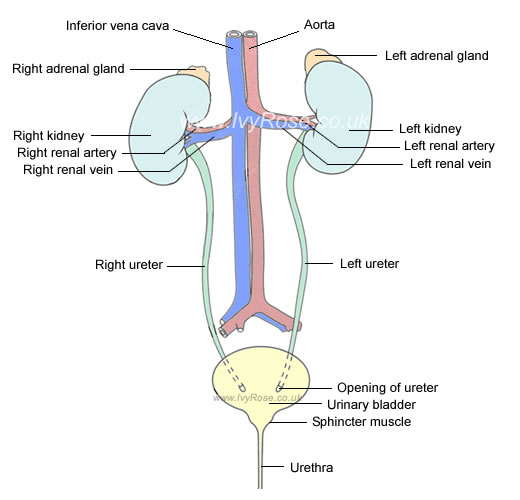
What is a UTI?
A urinary tract infection, or UTI, is a bacterial (or rarely fungal) infection of any part of the urinary system: the urethra, bladder, or kidneys. However, the term “UTI” generally refers to infections of the lower urinary tract — the bladder and urethra, collectively referred to as cystitis. Kidney infections, or pyelonephritis, is a particular kind of UTI, and generally treated as distinct from cystitis, both in its seriousness and treatment.
UTIs are characterized as uncomplicated or complicated based on whether they are associated with preexisting risk factors, e.g. organ transplants, catheters, and calculi (kidney stones). About 20 percent of patients seeking emergency care for UTIs each year have complicated UTIs, or cUTIs.
Escherichia coli, commonly E. coli, is the primary cause of urinary tract infections of any kind, and is responsible for 75 percent of uncomplicated UTIs, with bacteria of other species, notably Klebsiella and Enterococcus, accounting for the majority of the remaining cases. The chief difference between simple UTIs and complicated UTIs is that fungi, specifically those of the genus Candida, are far more likely to be implicated.
The primary risk factor for UTIs, by far, is sex: women are thirty times more likely to develop UTIs than men, and it estimated that nearly half of all women will develop a UTI in their lifetimes. This is primarily due to the anatomy of the female urinary tract, which is more exposed to pathogenic bacteria than the male urethra; among men, an uncircumcised penis is one of the most significant risk factors for a UTI, due to increased exposure of the urethra to bacteria. However, the risk for men generally is so low that circumcision reduces the risk only in about one in a hundred men.
Risk factors for women apart from urinary tract anatomy include pregnancy and age – pre-menopausal women are less likely to develop UTIs than postmenopausal women. Sexually active women are also more likely to develop UTIs than abstinent women, due to the increased exposure related to penetrative sex. (However, UTIs are not considered sexually transmitted infections, as they are transmitted peripherally to the genitals.) Use of antibiotics can also be a risk factor for women, as these can kill the native vaginal microbiome, which naturally inhibits the growth of pathogenic bacteria.
Risk factors independent of anatomy (and therefore applicable to men and women equally) include a compromised immune system, uncontrolled diabetes, kidney disease, urinary obstructions (e.g., kidney stones), and surgery to the urinary tract, particularly an indwelling catheter.
The symptoms of cystitic UTIs are generally limited to the affected area: typically these include painful urination (dysuria), increased urgency OR difficulty starting the urine stream (hesitancy), increased frequency of urination, and pain in the urethra or bladder. Blood in the urine (hematuria) is a less common symptom that may present with one or more of the above. Asymptomatic infections are possible, but by definition must either resolve spontaneously or develop into symptomatic UTIs. They are likely quite common, although the vast majority resolve spontaneously without need for intervention.
Definitive diagnosis of a UTI requires one or more urine test(s). Indications of an infection include high pH (above 8.0), presence of nitrites, and presence of white blood cells. The nitrate/nitrite test is the most accurate, as nitrites can only occur in the urine when produced by bacteria, but the test takes 6 hours to complete and so usually is done in the morning for same-day results. Visual inspection of the urine, whether macroscopic or microscopic, may support a diagnosis, but should never be the basis of a diagnosis.
Treatment of UTIs is a course of antibiotics, which may last anywhere from three days to six weeks, depending on the species of bacterium and nature of the infection. In simple, lower tract UTIs, treatment can be done at home and may not always be necessary: about 20% of UTIs resolve spontaneously without treatment. Cranberry juice, often cited informally as a home remedy, is effective in preventing UTIs and treating recurrent or relapsing infections, but has not been shown to be effective in treating acute UTIs.
Most lower UTIs present little risk for complications. The primary complications are infection of the upper urinary tract and development of a recurrent UTI, which responds to antibiotic treatment but returns after treatment has concluded. However, in rare cases UTIs may lead to kidney damage, permanent incontinence, and/or the development of kidney stones. UTIs during pregnancy may cause low birth weight in newborns.

What is a Kidney Infection?
A kidney infection is a type of urinary tract infection: it differs from cystitis only in the site of infection (although they can be concurrent). While cystitis is an infection of the lower urinary tract – the urethra and bladder – a kidney infection, technically pyelonephritis, involves the kidneys.
Kidney infections are more serious and harder to treat than cystitic UTIs, and are generally considered apart from them. This is why “UTI” and “kidney infection” commonly connote separate conditions, even though the latter is technically a subset of the former. Like cystitic UTIs, kidney infections may be complicated or uncomplicated, and are categorized as such by the same criteria.
Kidney infections are much rarer than UTIs in women: 10% of women develop a UTI annually, while only 0.15% of women will develop a kidney infection. Among men, the rate of kidney infections is about 3 to 4 in 10,000, about a tenth that of UTIs generally.
The symptoms of kidney infection include those of cystitis, with the exception of site of pain: in kidney infections, pain is concentrated in the flanks – usually one or the other, depending on the site of infection – rather than the bladder or groin. Additional symptoms of kidney infection include fever and nausea, with flank pain and fever the most common.
Diagnosis of kidney infection requires a urinalysis. Pyuria, or pus in the urine, is a common finding, and can help distinguish a kidney infection from cystitis. Blood in the urine and/or cloudy urine may be present, but these may be caused by other conditions presenting similar symptoms – e.g., kidney stones – and neither is diagnostic.
Treatment of kidney infections is principally via antibiotics, with analgesics and anti-inflammatory drugs to manage pain and soreness. Most kidney infections can be treated on an outpatient basis, but children, the elderly, and the immunocompromised may require inpatient treatment including intravenous administration of antibiotics. Symptoms of kidney infections usually clear within two days with treatment, but a course of antibiotics generally lasts two weeks, and patients should complete the course to prevent recurrence.
Kidney infections present a greater risk for complications than lower tract UTIs. These include formation of abscesses on the kidneys, thrombosis, sepsis, and even kidney failure. The very young, the elderly, and the immunocompromised are at greater risk for complications, and should be monitored closely for them.
Similarities Between UTIs and Kidney Infections
Similarities in Terms of “Pathology”
Both UTIs and kidney infections are caused by bacterial, or rarely fungal, infection. E. coli is the primary cause of both conditions.
Similarities in Terms of “Epidemiology”
Both UTIs and kidney infections are more prevalent among women, particularly pregnant or sexually active women, than among men. Children, the elderly, and the immunocompromised are at higher risk for both conditions.
Similarities in Terms of “Symptoms”
Painful urination, increased frequency or urgency of urination, and difficulty initiating urination are symptoms of both UTIs and kidney infections.
Similarities in Terms of “Diagnosis”
Urinalysis is necessary to describe either a UTI or a kidney infection. Presence of white blood cells or nitrites is diagnostic of both conditions.
Similarities in Terms of “Treatment”
Both kidney infections and UTIs are treated with antibiotics, and both can be treated on an outpatient basis in most cases.
Summary
- Medically speaking, kidney infections are a type of UTI — specifically an infection of the upper urinary tract. However, the term “UTI” generally refers only to infections of the bladder and urethra (cystitis).
- Both UTIs and kidney infections are caused by bacteria, or rarely fungi. The most common infectious agent in both cases is E. coli.
- Painful, frequent, and difficult urination are symptoms of both UTIs and kidney infections.
- Women are at much greater risk for both UTIs and kidney infections, particularly pregnant women and sexually active women. Children and the elderly are at higher risk for both conditions, as are the immunocompromised and people with a recent history of surgery on the urinary tract, especially indwelling catheters.
- Both UTIs and kidney infections are treated with antibiotics, either oral or intravenous. Both conditions are generally treatable at home with prescribed medications.
FAQ
Are UTI and kidney infections similar?
Yes. A kidney infection is simply a UTI in the upper urinary tract.
How to tell the difference between a UTI and kidney infection?
Symptoms of kidney infection often include fever and nausea, neither of which is commonly seen in UTIs. Kidney infections usually cause pain in the flanks, while UTIs cause pain in the groin or bladder area. Kidney infections, but not UTIs, often cause pyuria, or pus in the urine.
Can a UTI turn into a kidney infection?
Yes. This is the primary complication of untreated UTIs.
Can a kidney infection go away on its own?
Almost never. While UTIs frequently resolve without treatment, kidney infections rarely improve without antibiotics.
What is the main cause of kidney infection?
How serious is an infection in the kidney?
Apart from the pain, which can be debilitating, a kidney infection can lead to kidney failure or sepsis, and even be fatal.
How long do kidney infections last?
Kidney infections can develop quickly, in a matter of days, with onset of symptoms even more rapid. If treated promptly, symptoms should begin to improve within 24 to 48 hours, and the infection will be gone in 2 weeks. If left untreated, there’s no telling how long the infection might last, or how quickly it will develop into a more serious condition like sepsis.
What is the main cause of UTI?
The bacterium Escherichia coli or E. coli is the main cause of UTIs. Exposure to this bacteria is commonly due to penetrative sex, poor hygiene, or antibiotic treatment that disrupts the microbiome of the vagina.
Will a UTI go away on its own?
A UTI may resolve without treatment. Many UTIs never present symptoms and resolve spontaneously, while about a fifth of symptomatic UTIs get better without treatment.
How do you make a UTI go away?
A course of antibiotics prescribed by a doctor is the safest and quickest way to resolve a UTI. Natural remedies are generally not effective at treating UTIs, though they may help prevent them.












Leave a Reply